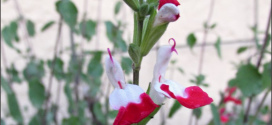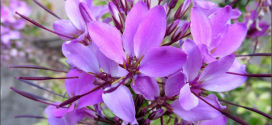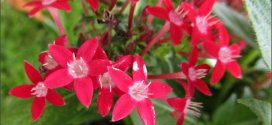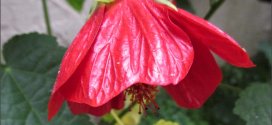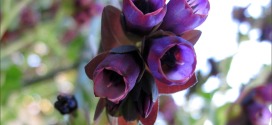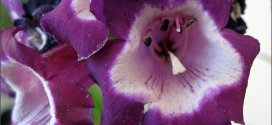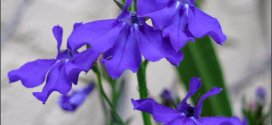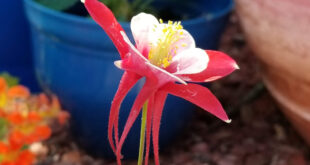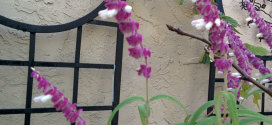Autumn Sage, Salvia x jamensis ‘Hot Lips’ Family: Lamiaceae (lay-mee-AY-see-ee) (Info) Genus: Salvia (SAL-vee-uh) (Info) Species: x jamensis Cultivar: Hot Lips Synonym:Salvia microphylla Category: Tropicals and Tender Perennials Height: 36-48 in. (90-120 cm) 4-6 ft. (1.2-1.8 m) Spacing: 18-24 in. (45-60 cm) Hardiness: USDA Zone 8a: to -12.2 °C (10 °F) USDA Zone 8b: …
Read More »Tag Archives: Hummingbirds
Cleome – Senorita Rosalita
Spider Flower, Spider Legs, Grandfather’s Whiskers, Cleome houtteana Family: Cleomaceae Genus: Cleome (klee-OH-me) (Info) Species: houtteana (hoot-AH-na) (Info) Synonym:Cleome hassleriana Synonym:Cleome sesquiorygalis Synonym:Tarenaya hassleriana Synonym:Cleome spinosa Synonym:Neocleome spinosa Category: Annuals Height: 36-48 in. (90-120 cm) Spacing: 18-24 in. (45-60 cm) Hardiness: Not Applicable Sun Exposure: Full Sun Danger: Plant has spines or …
Read More »Pentas – Scarlet Red
Pentas are tropical blooming plants. When you know how to grow Pentas, you have a foolproof way of attracting hummingbirds and butterflies, too.
Read More »Abutilon – Lucky Lantern Red
Various species within the genus Abutilon, including plants commonly referred to as flowering maple, Chinese lantern, Chinese bell flower and collectively as abutilon, are evergreen shrubs enjoyed for their maple-like leaves and bell-like, pendulous flowers. Hardiness varies by species, but most survive up to U.S. Department of Agriculture plant hardiness zone 8 or 9, and some cultivars are grown as …
Read More »Cerinthe – Blue Honeywort
Honeywort, Blue Shrimp Plant, Blue Wax Flower, Cerinthe major ‘Purpurascens’. This plant is attractive to butterflies, birds, and bees. The word “honeywort” means a plant that produces a lot of honey. Average Water Needs; Water regularly; do not overwater Family: Boraginaceae Genus: Cerinthe (ser-IN-thee) (Info) Species: major (MAY-jor) (Info) Cultivar: Purpurascens Additional cultivar information: (aka Purpurescens) Synonym:Cerinthe major …
Read More »Penstamon – Purple
Penstemon is a western United States native that has colorful tubular flowers on tall spikes. This prairie plant thrives in hot, sunny conditions and is a stunning addition to wildflower plantings. Another common name is beardtongue. About This Plant Penstemon forms dense spikes of tubular flowers in early to mid summer. Flower colors include pink, blue, red, purple, and white. …
Read More »Salvia – Blue Hills
Salvia × sylvestris ‘Blauhügel’ BLUE HILL. This salvia cultivar is a compact plant which typically grows only to 20″ tall. Features densely-flowered, spike-like racemes of pure blue flowers which bloom in June and continue throughout the summer. Flowers are attractive to bees and butterflies. A mint family member which has narrow, dark green, basal leaves (to 5″) and smaller stem …
Read More »Red Trumpet Vine
Red Trumpet vine has lots of pretty red flowers. I am warning you that it is an aggressive climber. You can see an example at the intersection of Matilda and Sunnyvale-Saratoga Road. Another example is on the south side of Sunnyvale-Saratoga Road past Fremont just past the Falefal-stop restaurant. I have a plant growing in a 3-inch wide trench and …
Read More »Columbine
Intense, dark rosy pink outer petals contrast beautifully with white centers on 2” wide, long-spurred blooms. Makes a great cut flower! Its vigorous upright, airy habit make it a nice addition to woodland gardens, sunny rock gardens, and cottage gardens. 2’x2’ when in bloom, with flowers borne on tall branching stems held about 1’ above showy, lacy foliage. Like its …
Read More »Salvia leucanthus – Mexican bush sage
Mexican bush sage (Salvia leucantha) is a beautiful, hardy plant for Alta California. This downy, bushy, evergreen subshrub produces white or purple flowers clasped by soft purple calyces from late summer to frost. It grows 3 feet tall by 3 feet wide, and is great for the border. Salvias are some of the showiest plants for containers, annual borders, and …
Read More »